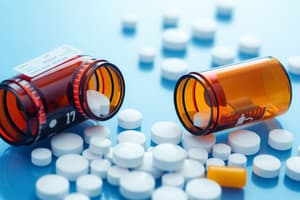Podcast
Questions and Answers
What is the relationship between the volume of distribution and the location of the drug in the body?
What is the relationship between the volume of distribution and the location of the drug in the body?
- The larger the volume of distribution, the more likely the drug is confined to the circulatory system.
- The larger the volume of distribution, the more likely the drug is found in the tissues of the body. (correct)
- The smaller the volume of distribution, the more likely the drug is found in the tissues of the body.
- The volume of distribution has no effect on the location of the drug in the body.
What is the primary function of albumin in drug distribution?
What is the primary function of albumin in drug distribution?
- To bind sex hormones
- To bind basic drugs
- To bind thyroid hormone
- To bind acidic drugs (correct)
What is the effect of binding to plasma proteins on a drug's concentration in tissues?
What is the effect of binding to plasma proteins on a drug's concentration in tissues?
- It has no effect on the concentration of the drug in tissues
- It limits the concentration of the drug in tissues (correct)
- It is dependent on the type of protein bound
- It increases the concentration of the drug in tissues
What is the role of fat in the body regarding lipid-soluble drugs?
What is the role of fat in the body regarding lipid-soluble drugs?
What is the term for the process by which a drug is distributed into tissues?
What is the term for the process by which a drug is distributed into tissues?
What determines the rate of delivery and potential amount of drug distributed into tissues?
What determines the rate of delivery and potential amount of drug distributed into tissues?
What is the effect of reversible binding to plasma proteins on the concentration of active, unbound drug?
What is the effect of reversible binding to plasma proteins on the concentration of active, unbound drug?
What is the term for the proteins that specifically bind to certain hormones?
What is the term for the proteins that specifically bind to certain hormones?
What happens to the concentration of active, unbound drug in intracellular water after distribution equilibrium is achieved?
What happens to the concentration of active, unbound drug in intracellular water after distribution equilibrium is achieved?
Which of the following is NOT a factor that affects drug transfer across the placenta?
Which of the following is NOT a factor that affects drug transfer across the placenta?
What is the primary mechanism by which the effect of a drug is terminated after withdrawal?
What is the primary mechanism by which the effect of a drug is terminated after withdrawal?
What is the primary determinant of drug penetration into the brain?
What is the primary determinant of drug penetration into the brain?
What is the main function of Phase I functionalization reactions?
What is the main function of Phase I functionalization reactions?
Which of the following statements about the blood-brain barrier is TRUE?
Which of the following statements about the blood-brain barrier is TRUE?
What is the primary role of drug metabolism?
What is the primary role of drug metabolism?
Which of the following is a characteristic of Phase II biosynthetic reactions?
Which of the following is a characteristic of Phase II biosynthetic reactions?
Which of the following statements about the termination of drug effect is TRUE?
Which of the following statements about the termination of drug effect is TRUE?
What happens to lipophilic compounds filtered through the glomerulus?
What happens to lipophilic compounds filtered through the glomerulus?
What happens to the half-life (T1/2) of a drug as clearance decreases due to a disease process?
What happens to the half-life (T1/2) of a drug as clearance decreases due to a disease process?
Steady state in pharmacokinetics refers to what?
Steady state in pharmacokinetics refers to what?
What percentage of drugs administered to humans are eliminated primarily through renal excretion?
What percentage of drugs administered to humans are eliminated primarily through renal excretion?
Which factor influences the amount of drug filtered into the tubular lumen during glomerular filtration?
Which factor influences the amount of drug filtered into the tubular lumen during glomerular filtration?
What process allows for the majority of filtered drugs to be reabsorbed back into the bloodstream?
What process allows for the majority of filtered drugs to be reabsorbed back into the bloodstream?
Why do lipid-soluble drugs tend to be poorly excreted in renal excretion?
Why do lipid-soluble drugs tend to be poorly excreted in renal excretion?
What is the primary effect of the ion-trapping phenomenon on basic drugs in acidic urine?
What is the primary effect of the ion-trapping phenomenon on basic drugs in acidic urine?
What happens to polar drugs of low tubular permeability during renal excretion?
What happens to polar drugs of low tubular permeability during renal excretion?
Which of the following factors does NOT affect the amount of drug entering the tubular lumen?
Which of the following factors does NOT affect the amount of drug entering the tubular lumen?
Which of the following is NOT a factor in determining if two drug products are considered pharmaceutical equivalents?
Which of the following is NOT a factor in determining if two drug products are considered pharmaceutical equivalents?
What is the primary advantage of administering drugs via the pulmonary route?
What is the primary advantage of administering drugs via the pulmonary route?
Which of the following scenarios would necessitate direct injection of drugs into the spinal subarachnoid space?
Which of the following scenarios would necessitate direct injection of drugs into the spinal subarachnoid space?
What is the 'first-pass effect' in drug pharmacokinetics?
What is the 'first-pass effect' in drug pharmacokinetics?
Why is the volume of distribution (VD) an important pharmacokinetic parameter?
Why is the volume of distribution (VD) an important pharmacokinetic parameter?
Which of the following is NOT a characteristic of the pulmonary administration route?
Which of the following is NOT a characteristic of the pulmonary administration route?
What is the primary function of the meninges in the central nervous system?
What is the primary function of the meninges in the central nervous system?
What is the relationship between bioavailability and the first-pass effect?
What is the relationship between bioavailability and the first-pass effect?
Flashcards are hidden until you start studying
Study Notes
Injection Techniques
- Injection into deltoid or vastus lateralis leads to faster absorption compared to gluteus maximus.
- Female patients show slower absorption in gluteus maximus due to subcutaneous fat distribution.
- Drugs too irritating for subcutaneous injection can be administered intramuscularly.
Subcutaneous Injection
- Subcutaneous injections should only involve non-irritating drugs to avoid severe tissue damage.
- Absorption rate from subcutaneous injections is often consistent and slow, aiding sustained drug effects.
- Incorporating a vasoconstrictor in a subcutaneous drug solution can slow absorption.
Intra-Arterial Injection
- Direct intra-arterial injection localizes drug effects in specific tissues, beneficial for liver tumors and head/neck cancers.
Intrathecal Injection
- Intrathecal injections bypass blood-brain and blood-cerebrospinal fluid barriers for immediate effects on CNS, useful in spinal anesthesia and acute CNS infections.
Pulmonary Administration
- Non-irritating gaseous and volatile drugs can be inhaled, rapidly absorbed through pulmonary epithelium.
- Pulmonary route allows immediate drug absorption and avoids hepatic first-pass metabolism, ideal for targeting pulmonary diseases.
Bioequivalence
- Drug products are pharmaceutical equivalents if they share the same active ingredients and demonstrate similar bioavailability under test conditions.
Bioavailability
- Bioavailability refers to the fraction of drug entering systemic circulation; high liver and intestinal metabolism may significantly reduce it (first-pass effect).
Distribution of Drugs
- After absorption, drugs distribute into interstitial and intracellular fluids based on volume of distribution (VD).
- Large VD suggests high likelihood of drug presence in body tissues, while small VD indicates confinement within the circulatory system.
- Factors influencing drug distribution include cardiac output, blood flow, capillary permeability, molecular size, lipid solubility, and binding to serum proteins.
Plasma Proteins
- Many drugs bind to plasma proteins like albumin and α1-acid glycoprotein; binding is generally reversible.
- Concentration of drugs at their site of action is limited by binding to plasma proteins, as only unbound drugs can cross membranes.
Tissue Binding and Reservoirs
- Lipid-soluble drugs are stored in fat, which can act as a reservoir, leading to drug redistribution post-administration.
- Drug effect termination occurs primarily through metabolism, excretion, or redistribution from action sites to other tissues.
Blood-Brain Barrier
- Drug penetration into the brain relies on transcellular transport through tight junctions of endothelial cells.
- Lipid solubility and non-ionized forms are key determinants for brain drug uptake; inflammation can increase permeability.
Placental Transfer of Drugs
- Drug transfer across the placenta is influenced by lipid solubility, plasma binding extent, and ionization degree of weak acids and bases.
Drug Metabolism (Biotransformation)
- Biotransformation generally produces polar, inactive metabolites for easier excretion; lipophilic compounds may be reabsorbed in the renal tubules.
- Classifications:
- Phase I: Functionalization reactions (oxidation, reduction, hydrolysis).
- Phase II: Biosynthetic reactions (conjugation).
Phase I Reactions
- Introduce functional groups on drugs, making them reactive for further conjugation.
- Liver performs significant Phase I reactions, and decreased clearance may lead to increased half-life.
Steady State
- Achieved when drug intake is balanced with its elimination, indicating stable plasma concentrations.
Renal Excretion
- Renal excretion accounts for a major route of elimination for 25-30% of drugs; it involves:
- Glomerular filtration: Dependent on filtration rate and drug binding; only unbound drugs are filtered.
- Passive tubular reabsorption: Lipid-soluble drugs are poorly excreted, while polar drugs concentrate as water is reabsorbed.
- Ion-trapping effect: Basic drugs are excreted faster in acidic urine, promoting their charged form and inhibiting reabsorption.
Studying That Suits You
Use AI to generate personalized quizzes and flashcards to suit your learning preferences.



